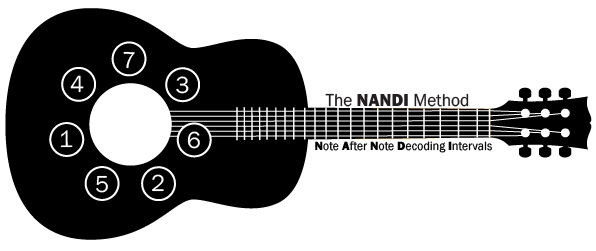We have previously covered major and minor scales. We also have discussed relative scales, like C major and A minor, which have the exact same key signature. Another name for these scales are C Ionian and A Aeolian. There are actually seven total scales, or modes, in that set of notes. Just like we make A the root to play A Aeolian, if we made D the root we would be playing in D Dorian. Just like A minor and C major, any scale built on only natural notes will have the same key signature (because none of them have sharps or flats), but they would all have a different order of intervals.
There are seven modes in total, each consisting of slightly different scale degrees. Each mode will contain one augmented fourth. Below we will show each mode in scale degrees and show it on the fretboard:
Ionian
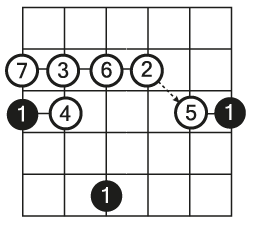
In scale degrees:
1 – 2 – 3 – 4 – 5 – 6 – 7
In order of fourths:
7 – 3 – 6 – 2 – 5 – 1 – 4
Augmented fourth:
4 – 7
Dorian
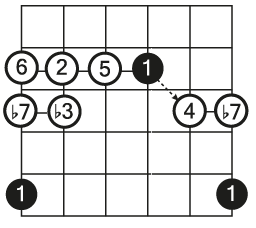 In scale degrees:
In scale degrees:
1 – 2 – ♭3 – 4 – 5 – 6 – ♭7
In order of fourths:
6 – 2 – 5 – 1 – 4 – ♭7 – ♭3
Augmented fourth:
♭3 – 6
Phrygian
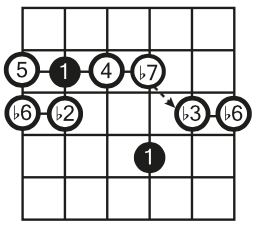
In scale degrees:
1 – ♭2 – ♭3 – 4 – 5 – ♭6 – ♭7
In order of fourths:
5 – 1 – 4 – ♭7 – ♭3 – ♭6 – ♭2
Augmented fourth:
♭2 – 5
Lydian
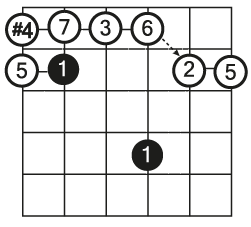 In scale degrees:
In scale degrees:
1 – 2 – 3 – #4 – 5 – 6 – 7
Lydian is the only natural mode with a sharp scale degree
In order of fourths:
#4(♭5) – 7 – 3 – 6 – 2 – 5 – 1
Augmented fourth:
1 – #4 (♭5)
Mixolydian
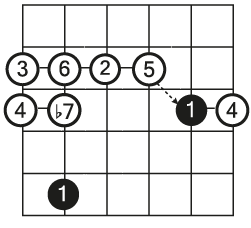
In scale degrees:
1 – 2 – 3 – 4 – 5 – 6 – ♭7
In order of fourths:
3 – 6 – 2 – 5 – 1 – 4 -♭7
Augmented fourth:
♭7 – 3
Aeolian (Minor)
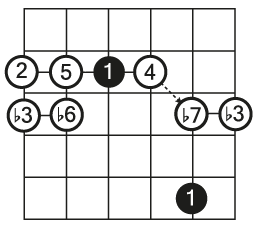
In scale degrees:
1 – 2 – ♭3 – 4 – 5 – ♭6 – ♭7
In order of fourths:
2 – 5 – 1 – 4 – ♭7 – ♭3 – ♭6
Augmented fourth:
♭6 – 2
Locrian
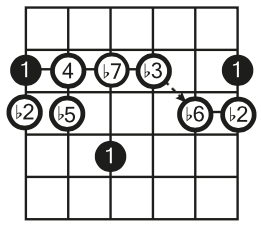
In scale degrees:
1 – ♭2 – ♭3 – 4 – ♭5 – ♭6 – ♭7
In order of fourths:
1 – 4 – ♭7 – ♭3 – ♭6 – ♭2 – ♭5
Augmented fourth:
♭5 – 1
And that’s every mode and how to visualize them using fourths. You should note that the Lydian mode is the only mode with a tritone, between the 1 and #4, and the Locrian mode is the only mode with a tritone, between the 1 and ♭5. Locrian is often called the diminished mode because when it’s notated in roman numerals the root chord is diminished (i°).
Modes that have a major root chord are considered the major modes:
Ionian, Lydian, and Mixolydian
While those with a minor root chord are considered the minor modes:
Aeolian, Dorian, and Phrygian
Just be careful to make sure you have enough context to know if you’re playing in a mode or not. If someone just says “major”, they mean Ionian, not Lydian or Mixolydian. Likewise, if someone says a song is “minor” without specifying a mode, they mean that it is in Aeolian, not Dorian or Phrygian.
Understanding Modes With Seventh Chords
Listed in the table below, are intervals in the various modes from which you will find 4 types of seventh chords: major seventh (e.g. Cmaj7), minor seventh (e.g. Cm7), dominant seventh (e.g. C7) and minor seventh-flat-five (e.g. Cm7♭5). You will find that all modes will have the same seventh chords, meaning each mode has two Major Seventh Chords, three Minor Seventh Chords, one Dominant Seventh chord, and one Minor Seventh flat-five. In the key of C, minor seventh chords are only from notes E, A and D, dominant seventh chord from G, major seventh chords from C and F, and minor seventh-flat-five chords from B. Notice the fourth order I have listed these chords- E-A-D-G-C-F-B.
[supsystic-tables id=1]
A shortcut to know the chords in any key is to use the notes and corresponding chords of the C major scale as a reference. Minor seventh chords in the C major scale are from intervals 3, 6 and 2 (3-6-2 intervals are a fourth apart). The first mode of the C major scale is C Ionian where the minor seventh chord, Emin7, is a major third from root C, and is followed by two minor seventh chords whose roots are a fourth apart which is Am7 and Dm7. Transposing the 3-6-2 to G Ionian where B is a major third, the min seventh chords in that mode will be Bm7, Em7 and Am7 from intervals 3, 6 and 2 (B, E and A are a fourth apart)
In any given mode you will find three minor seventh chords, two major seventh chords, one dominant chord and one half-diminished chord. Putting these chord types in “fourth” order (3-6-2-5-1-4-7) in the Ionian mode: minor sevenths are from 3-6-2, dominant seventh from 5, major sevenths from 1-4, and min7♭5 from 7.
Listed in the table below, are intervals in the various modes from which you will find minor seventh chords. Also notice the pattern of fourths that these intervals follow from one mode to the next. If you are in the Ionian mode, the first minor seventh chord is from 3, in Dorian it is from 2, in Phrygian it is from 1. You are going down an interval (3, 2, 1, etc) as you progress from one mode to the next. The next two minor sevenths that follow are a fourth apart.
[supsystic-tables id=2]
![]()
For any Dorian mode, you will find minor sevenths from intervals 2, 5 and 1. If you are in any Dorian mode, whether it is A Dorian or F# Dorian, the minor seventh chords are always from intervals 2, 5 and 1. In F# Dorian the minor seventh chords are G#m7, C#m7 and F#m7 (F# to G# is a second). There is only one dominant seventh chord in a major key. in F# Dorian it will be from the next fourth following F# which is B or B dominant seventh. Fourths following B are E and A from which you have major seventh chords – Emaj7 and Amaj7 from intervals ♭7 and ♭3 of the Dorian mode. So if you have minor seventh chords from 2, 5, 1 there is a dominant seventh chord from 4, followed by major seventh chords from ♭7 and ♭3. The last remaining interval is 6 from which you have a minor seventh-flat-five chord.
Yet another way to know your min7th chords in any mode is to associate the relationship of the letter E (Emin7) to the letter which represents the mode. Associate D with Dorian, E with Phrygian, F with Lydian, etc. In Dorian (D), note E is a major second from D. So the first min7 chord in Dorian mode, will always be from 2, followed by 5 and 1 (fourths from 2) in any key. In Lydian (F), note E is a seventh from F. So the minor seventh chords in a Lydian mode will start from 7, followed by 3 and 6. In Phrygian (E) note E is the same as 1 or E. So the minor seventh chords in a Phrygian mode will start from 1 and followed by 4 and ♭7.
In the key of F: A Phrygian- the min7th chords will be from 1, 4, ♭7 or Am7, Dm7 and Gm7. In G Dorian, the min7th chords will be from 2, 5, 1 or Am7, Dm7 and Gm7.
There are two major seventh chords in any major scale mode. Associate the relationship of the letter C to the mode letter. In Dorian (D), C is ♭7 (D-C is a min7th). So going up a fourth from ♭7 is ♭3. So the maj7th chords in a dorian mode will be from ♭7 and ♭3. In a Phrygian(E) mode, the maj7th chords will be from ♭6 and ♭2 (E-C is a ♭6, E-F is a ♭2).
For half-dim7 chords, associate the letter B with the mode letter. In Aeolian (A) B is a second from A, so you will always have a half-dim7 chords from interval 2 of the Aeolian mode. For Lydian (F) it is from #4 (B-F is a tritone), for Locrian (B) it is from 1, Dorian(D) it is from 6 (D-B is a sixth) , Phrygian it is from 5 (E-B is a fifth).
